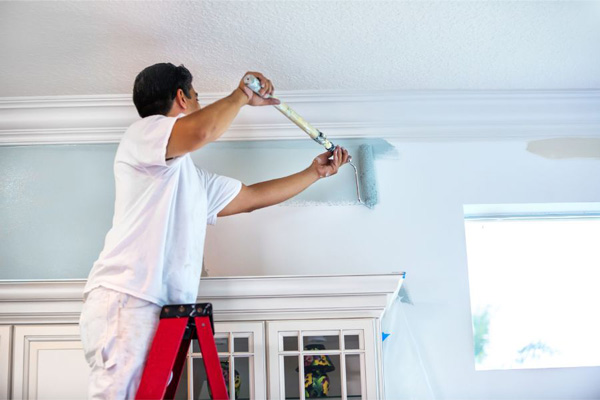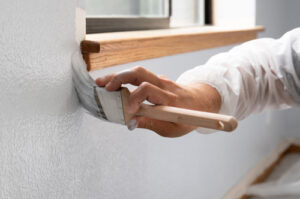
Interior painting revitalizes living spaces, injecting freshness and personality into a home. Whether seeking a subtle shift in color or a dramatic transformation, initiating an interior painting endeavor demands meticulous planning, preparation, and familiarity with the process.
Let’s navigate the key facets of an interior painting project, encompassing vital steps, considerations, and tips crucial for achieving a successful outcome. From the initial planning stages to the final touches, understanding the nuances of interior painting empowers individuals to embark on this transformative journey with confidence.
Preparing For the Project
Prior to commencing the painting process, it’s important to evaluate the project’s scale, create a budget, and define a timeline. Assess the areas needing paint—be it walls, ceilings, trim, or accent sections—to accurately estimate material and labor expenses.
The selection of paint colors and finishes holds substantial importance in realizing the desired ambiance. Experiment with paint samples, considering how lighting conditions interact with chosen hues to ensure they harmonize with the space. Careful consideration at this stage significantly influences the overall outcome, impacting both the aesthetic appeal and the project’s financial and temporal aspects.
Preparing the space for painting is a meticulous process that begins with clearing the area, cleaning surfaces, and attending to any necessary repairs. Start by relocating furniture and safeguarding floors with protective drop cloths. Secure edges with painter’s tape to shield fixtures and borders. Thoroughly clean walls and ceilings to ensure optimal paint adhesion, eliminating dust, dirt, and grease. Addressing any cracks or damages by patching and smoothing surfaces contributes to a flawless finish. This step-by-step preparation lays the groundwork for a successful painting project, creating an ideal canvas for the application of fresh coats of paint.
Hiring Professional Help vs. DIY Approach
Deciding between hiring professional painters or tackling the project yourself hinges on multiple considerations. Professionals bring expertise, efficiency, and high-quality outcomes, adept at managing intricate details and overcoming challenges. Their skills ensure a smooth, well-executed job. Conversely, DIY endeavors can be cost-efficient and gratifying, especially for smaller areas or straightforward tasks, albeit demanding more time and effort.
Weighing factors like project complexity, available time, budget, and desired quality of results helps determine the most suitable approach—whether to enlist professionals for a polished finish or engage in a DIY venture for a hands-on, budget-friendly experience.
Understanding the Painting Process
The painting process beings with meticulous surface preparation, including tasks like sanding, patching holes, and applying primer for improved adhesion and a uniform surface. Selecting appropriate tools—be it brushes, rollers, or sprayers—is vital. Applying multiple coats evenly and allowing ample drying time between each layer are crucial for achieving a polished, professional finish. This systematic approach ensures the paint adheres effectively and results in a consistent, aesthetically pleasing outcome.
Dealing With Challenges
During painting, unexpected challenges may arise, such as discovering mold or encountering uneven surfaces. Addressing these issues promptly is crucial. Troubleshooting common painting problems like drips or streaks requires patience and the right techniques. Being adaptable and adjusting the plan as needed helps navigate through unforeseen obstacles.
Post-Painting Care and Cleanup
Upon completion of the painting process, it’s imperative to meticulously inspect the finished work for uniformity and excellence. Take care when removing painter’s tape and protective coverings to prevent any unintended damage to the freshly painted surfaces. Extending the lifespan of brushes, rollers, and other tools involves thorough cleaning. As you reorganize the space and reintroduce furniture, exercise caution to avoid any contact with or disruption to the newly painted areas. This final phase is crucial in preserving the pristine appearance of the freshly painted interior.
Final Touches and Enhancements
Enhance your space with flair by opting for accent walls or creative finishes. Experimenting with various painting techniques—such as stenciling or faux finishes—injects character into your interiors. These additions elevate the ambiance, offering a unique touch to your newly painted walls. Complement the refreshed look with final decorative elements, like curated artwork or stylish accessories. These thoughtful details transform your space, adding depth and personality to the overall design scheme.
Start your Interior Painting Project with Revel Painting
Undertaking an interior painting project presents an exciting opportunity to infuse personality and rejuvenate the atmosphere of your living spaces. Success in this endeavor hinges on meticulous planning, a grasp of the process, and adeptly navigating any challenges.
Whether opting for professional assistance or embracing a DIY approach, achieving exceptional results demands attention to detail and precise execution. Ultimately, a well-executed interior painting project will leave your home refreshed and exuding vibrancy.
Each phase—from the initial preparations and execution to troubleshooting challenges and adding those final artistic flourishes—plays a pivotal role in attaining a gratifying outcome. Armed with the right approach and knowledge, the transformation of living spaces through the transformative power of paint becomes a fulfilling and enjoyable journey. For top-tier interior painting services, connect with Revel Painting today at 612-345-9136.






